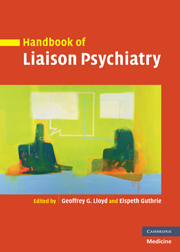Book contents
- Frontmatter
- Contents
- List of contributors
- Preface
- Part I Basic skills
- Part II Common psychiatric problems across the general hospital
- 7 Functional somatic syndromes
- 8 Alcohol problems in the general hospital
- 9 Drug misuse in medical patients
- 10 Sexual problems in medical patients
- 11 Suicide and deliberate self-harm
- 12 Delirium
- 13 Childhood experiences
- Part III Working with specific units
- Part IV Treatment
- Part V Different treatment settings
- Index
- References
13 - Childhood experiences
from Part II - Common psychiatric problems across the general hospital
Published online by Cambridge University Press: 10 December 2009
- Frontmatter
- Contents
- List of contributors
- Preface
- Part I Basic skills
- Part II Common psychiatric problems across the general hospital
- 7 Functional somatic syndromes
- 8 Alcohol problems in the general hospital
- 9 Drug misuse in medical patients
- 10 Sexual problems in medical patients
- 11 Suicide and deliberate self-harm
- 12 Delirium
- 13 Childhood experiences
- Part III Working with specific units
- Part IV Treatment
- Part V Different treatment settings
- Index
- References
Summary
Experiences in childhood can have a tremendous influence on wellbeing in adulthood, and on the ways in which illness presents in adulthood. Conversely, illness in a parent, and the way the illness is managed, can have a great impact on the children in the family. This chapter will examine these two areas, examining the knowledge base and the implications for practice in adult liaison psychiatry. It will not attempt to cover every aspect of the field. The influences on children's health and development are manifold, and not all of those influences are relevant to liaison psychiatry. The chapter will therefore focus on those areas which have been best researched, and which have the greatest potential significance for the adult liaison psychiatrist.
Adult psychiatrists might also wish to bear in mind that the pathways into child psychiatric disorder are complex, as will be seen from the research quoted below. When a parent suffers from a particular condition, physical or psychological, that condition might have a direct effect on the parent's behaviour with the child, or on the child's thoughts and anxieties about the parent. However, the effects on the child might be influenced by other factors, such as the impact of parental illness on the marriage, the level of functioning of the healthy parent, and the child's relationship with that parent. Illness and bereavement may result in financial difficulties, so that the children need to be looked after by other carers.
- Type
- Chapter
- Information
- Handbook of Liaison Psychiatry , pp. 290 - 302Publisher: Cambridge University PressPrint publication year: 2007



